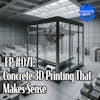EP #058: Challenging Concrete Trends: AI, CO2 Emissions, & Type 1L
Get ready for a no-holds-barred conversation on the Concrete Logic Podcast! In this episode, we’re bringing back Matt “Mr. Concrete” McCombs, a veteran of the ready-mix industry and a die-hard Ohio State Buckeyes fan. We’re diving deep into the controversial topics that are shaking up the concrete industry. From the push for reducing CO2 emissions to the introduction of Type 1L cement, we’re tackling it all.
But that’s not all. We’re also exploring the role of AI in the industry and the promises it holds for making ready-mix designs more efficient. But are these solutions as good as they sound? Or are they just creating more problems for suppliers and contractors?
Join us as we challenge the status quo, question the established methods, and seek innovative solutions. This is an episode you don’t want to miss. Tune in to the Concrete Logic Podcast and let’s get the concrete conversation started!”
And remember, if you want to stay updated with the latest industry insights, don’t forget to sign up for our weekly knowledge email bombs. You can also follow us on your favorite podcast app. Let’s build a stronger future for concrete together!
Do you enjoy the Concrete Logic Podcast? If so, please consider donating $5 to support the show: https://buy.stripe.com/9AQ4gP8Mu83Z3045km
Episode References
Guest: Matt McCombs | Mr. Concrete | mgmccombs40@gmail.com
Guest Website: https://www.linkedin.com/in/matt-mr-concrete-mccombs/
Producers: Jodi Tandett, Olivia Stocker
Donate & Become a Producer: https://www.concretelogicpodcast.com/support/
Music: Mike Dunton | https://www.mikeduntonmusic.com | mikeduntonmusic@gmail.com | Instagram @Mike_Dunton
Host: Seth Tandett, seth@concretelogicpodcast.com
Host website: https://www.concretelogicpodcast.com/
Seth: [00:00:00] And welcome to another episode of the Concrete Logic Podcast. And today I have Matt "Mr. Concrete" McCombs on the podcast. I think this is, we were talking before, I think you've been on three or four times, but Matt has worked in the ready mix industry for a long, time. That's why he’s on here today.
I want to get his perspective on a couple of things. Matt, is there anything else other than he's, an enormous Ohio State Buckeyes fan other than that, what did I miss Matt?
Matt McCombs: I think you got it covered with the Ohio State piece.
Seth: Yeah. And then before we get started today, because I think I have to warn folks that when I talk to Matt, I'm a little bit freer with what my opinions are. Matt brings that out in me.
So just to [00:01:00] let you all know that what I say today is my personal opinion doesn't reflect on my employer. They don't necessarily share the same opinions as me. So just want to make that clear Matt, today I wanted to bring you on because there's some companies out there that are good and bad, I guess you could say that are suggesting solutions to the concrete industry as far as fixing several things. we've talked about this 100 times on this podcast about reducing our CO2 emissions. There’s that issue out there, right? There is a new I don't know if you heard Matt, but there's a new, Cement out there, it's a Type 1L cement.
If you haven't heard.
Matt McCombs: I heard something about it.
Seth: there's that issue and the, issues that we've [00:02:00] been that's been challenging the industry for many, years just providing a quality product out there. So, on top of the usual, we've had the C02 and, the Type 1L challenges.
So these, companies and we, won't name names or anything, but maybe we will cause Matt likes to name names, but these companies are saying, Hey, if you want to reduce your CO2 emissions as a concrete, supplier or contractor, there are ways we can help you. And, there's folks that are using AI, which is a very popular thing right now.
People like to say AI, artificial intelligence that say, hey, we can take your, designs, your Ready-mix designs, and we [00:03:00] can show that you, can make those more efficient. So basically, telling us, Hey, if you take these certain products out of your mix design, that'll reduce your CO2 emissions and, you'll make the owner or your, client be it a GC or construction manager, whatever, you'll help them achieve their goals for the project.
I want to bring Matt on today is to get his, view as a ready mix supplier, what he thinks of that situation, how what's your view of something like
Matt McCombs: that?
I'm not currently working for a ready mix supplier, but like you said, I for a long time. That's what I did.
And these people or these groups have been around. Since the beginning of ready mix right there, they've come up with a way to reinvent the wheel or to reduce the amount of Portland [00:04:00] cement that you need to use and it's going to cost less. It's going to be more sustainable. It's going to be this, that and the other.
All you got to do. In order to make this work, add this product or add or design this way. And I think from the 1st point that I'll make okay, so you're telling me if we utilize your technology, then we can do all this stuff. We can start to work wonders and crap cucumbers
I was like, are you going to be the one that owns the responsibility for the performance of this mix when we use your technology? Or is that still on us? Do we still have the responsibility for the performance of the concrete? Because. We already have enough problems keeping things consistent, trying to make the same concrete mix day in and day out for our customers so that they [00:05:00] they feel like things aren't changing.
The customers that know anything about concrete will want to go and they have a mix. They like to use want to guard the integrity of that mix. They don't want you messing around with it.
And they feel okay, if you're going to start pulling cement out of it, which is your most expensive component, then shouldn't we be getting like a price decrease because now the mix no longer has the same amount in there. So, there's a lot of things going on there that, a ready-mix supplier doesn't want to change because it just creates brain damage, it creates headaches, it creates problems, and sometimes those problems can lose a customer, lose a job.
When I worked for Martin Marietta here in Colorado, we would have anywhere from three to five hundred different orders every day. And in those 3 to 500 orders, you probably got close to 250 to 300 different clients [00:06:00] that are ordering this concrete. And if you think about trying to keep all those people happy and keep this whole thing moving forward without having a big speed bump all it takes is one big speed bump and that whole thing goes off the rails and it is a difficult.
Just absolutely painful experience to get it on the track. So that's why a lot of ready mix suppliers don't want to change anything, or they get the stereotype of being really conservative and slow to change is because, man there's, a lot going on here that you'd be surprised how little of a ripple turns into a tidal wave at the end of the day.
And then people are just dealing with stress. They don't need to. So that's my knee jerk reaction to anybody that has anything that says it's going to improve your concrete, all you gotta do is fill in the blank.
Seth: Yeah. Cause like you [00:07:00] said. You got all those orders. You got all those clients to take care of.
So, anyone going in there and changing just a small bit on a mix design, I can see how that kind of ripples across everybody. On a is there a bucket, like how many mixed designs does a typical plant deal with? Is it? 10 is a 12? Does that make sense? You have a 3000 mix, a 3500, maybe a 4000 and a 5000 and up.
How many mix designs does a typical plant deal with?
Matt McCombs: I'll give you an example of the scenario I was working in. So, we had, I think it got up to about 20 plants in Colorado. Okay. Each one of those plants [00:08:00] you like to have as few mixes as possible. But even though we were actively trying to minimize the amount of mix designs, those plants had to contend with at the end of the year, they each would have probably batched 300 and some different mix designs.
Somewhere, and then probably 80% of your volume was with the top 20 mix designs, right? And they're the ones you're going to produce the highest volume of. So, they should be your most consistent workhorse mixes and the easiest to batch with predictability. And then you get these one- offs that Come in here there. You do it once a week or once a month Once you have a batch to mix out of your plant for a week or two weeks The chance of it you being able to just batch it like you did the last time The same water trend, the [00:09:00] same effort using the same amount of water reducer or any other chemical you may have and get the same results.
Just forget it. you have to almost reapproach it. You're walking up trying to feed a grizzly bear a piece of chicken. You have to be a little bit careful because if you batch a load of concrete during the day, especially a busy time of day and you screw it up, and that truck has to go dump that load, or you have to leave the truck under the plant while the batch guy is trying to dry it up or figure out what went wrong so that they can fix it is the accordion effect that we often hear where 1 gets on the freeway, go on 20 miles less than everybody else and the next thing you got a traffic jam, right?
You got a log jam behind that truck and then people get in a hurry and then it's invariably more stuff gets messed up. But [00:10:00] so, yeah, you're as far as number of mixes, but let me throw another, wrench into this whole thing, and that is in Denver, just in Denver, around the city, we had, I think, 12 plants, and those 12 plants used 4 different cements, 7 different supplementary cementitious materials, 6 different sand sources, 7 different coarse ag sources, and it got to the point In the last few years where you didn't know which one of them was going to be available to you tomorrow and basically it got as bad as whatever truck showed up and what it had in it to dump in your silo or your pile is what you have to run with today because people were we were getting put on allocation.
Which is starting to ease up a little bit and things are a [00:11:00] little more available, but those mixes that I mentioned that, The top 20 or 30 that did 80% of your volume that were had a more confidence that I could batch this thing and get the properties I want. Then you add a different material in there today than yesterday and that changes.
So then, everything's geared towards don't change anything, nothing, because I might be standing here talking to you, Seth, but then I've got 20, 30 people behind me that are responsible for running plants. And then another 200 and some that were delivering concrete. We don't want them to do something today that creates a problem inadvertently, because now I got a new Mix a new material in the mix that creates some form of an instability or a change in performance or not accustomed [00:12:00] to.
So it is not easy to bring a new material in, especially when you're just going to do a test, or you're going to do a small change for a short period of time, just to observe and test and get test results and see how it performs. It's not easy to do.
Seth: So, for something like that, where you want to introduce a new product or a new mix design, it would have to be a substantial size project.
Matt McCombs: 1, it has to make sense for some reason other than perhaps just because sustainability is a big topic today doesn't mean it's high on everybody's priority list. They may say it is, they may not say that it isn't, but If I was going to go to a ready-mix supplier and try to talk them into trying [00:13:00] something new, I know that there has to be something inherent in using this product, or my involvement that is going to make an improvement for the ready-mix supplier, or ease concern, like all those things I just brought up as a potential liability.
The product that I'm using should have answers for that. So that they have a high level of comfort that I, okay, so then if I put this in the concrete mix design and we go out to a job, and somebody farts it's not going to work. It's not going to make strength, right? I got to convince them that's not
Seth: a concern.
what else would, convince a ready mix supplier to let someone change
Matt McCombs: something.
I'll give you an example. Baker in Colorado was interested in a corrosion inhibitor solving problems for [00:14:00] everybody. The dosage, instead of it being 2 gallons per cubic yard, a calcium nitrate corrosion inhibitor, like we always used, now we were using 1 pint per cubic yard.
it didn't impact the set time of the concrete at all. Practically inert. It was like dumping a 16 ounce bottle of water into per cubic yard into your truck. So, there'd be 10 of them, right? 10 cubic yards per truck. You add 10 bottles of water. Nobody's even going to be able to tell it's in there.
We were like, okay that sounds like a good idea. Let's try it because now even though it's new, there's less of it has less of an impact on the mix. It's not an accelerator. It's just an inert. Basically inert.
It's not inert, right? Or we wouldn't be putting that in there, but it doesn't have an impact on your fresh properties or ability to hold slump on the way to the job, or it [00:15:00] doesn't blow up on the finisher in the middle of a poor and get hard suddenly.
Yeah, that made sense. So, it solved several problems for us and them. And everybody practically because we could ease, it would be easier for everybody to, to team up and provide that high quality product that you mentioned in the beginning of this segment. So that makes sense.
Seth: Yeah.
Was that what you said? It was a new ad mixture for that plant, or was it just a reduction of an existing ad mixture?
Matt McCombs: I don't know how long this product had been around. Can I say it? Does it matter?
Sure.
Cortec MCI 2005 was the product and we'd been hearing from them for a couple years on, hey, try this.
And it's okay we got to get it approved and we got to get it tried out by somebody. Somebody's got to buy off on this to use it. So, we can figure out how well it [00:16:00] works. Baker handled that for us, so it was something that was, had been around for a little while and they were doing the legwork of getting the engineers on the project where they were supplying concrete to approve it now.
So that's like the pull approach, right? It's easier when your customer says, I want to use this instead of some, somebody comes into my office and says, I've got a new product that I want you to use in your ready makes concrete. Now, let's go convince all your customers. They want to use it too. Or better yet, let's just not tell them it's in there. Right and then it'll be a big surprise when something goes wrong, but. Yeah, so that was easy when the customer came with the product and said, we want to try this and our concrete because we're actually the ones finishing the concrete anyway.
That's a tough sell. If you're trying to do it the other way around. They're trying to convince the finisher he wants me to [00:17:00] put this in there and it's going to be okay. And then there's not a risk that when something goes wrong, he doesn't blame it all on that new product that I put in there and never want to use it again.
Seth: In that instance, was there a shared risk in using that product? or was it all on the contractor? Or was it all on you all? I don't know if you know the details of that or not.
I
Matt McCombs: do. that was one of the things when you first asked me about this, one of the first things I wrote down was risk and fear, Were two big things that I thought of as the challenges with trying new things out with whether it's to make a more sustainable mix or a better finishing mix or anything new, right? In this game, we play every day a lot of the responsibility for the performance is gonna fall on the person who is supplying this product we're trying, [00:18:00] because they know if I give you guys something and I allow it, if it fails, you'll never use this again.
Probably. It'll be really, unlikely for you to still use this on the next project. If I give it to you, you put it in the concrete, and it creates problems.
So, they know that going into it, so they have to make sure that they're giving us something they're confident in. Then, as far as that scenario we just talked about, Baker had a lot of risk because they're the ones that convinced the engineer to accept it, to approve it, and if it wasn't going to work, then they weren't going to look too good the next time they want to try something different.
And you still have to deal with this concrete we put on the ground with it in there. And then with them, they've of course had talked to us about, hey, are you confident in this? [00:19:00] Do you think it'll work from a supplier standpoint? Do you see anticipate problems or does it seem like a no brainer?
Does it seem and we had already tried it in our lab. We tried new things all the time. And just we were fortunate that we could take that was outside of the normal day to day where we could play around and figure out if stuff worked or not. And get it fine-tuned and dialed in before we ever even introduced it at the plant level.
So there, yeah, there's a level of shared responsibility there, but I think some, parties had a little bit more of it than others.
Seth: Yeah. That makes sense. Can't just put it on the Ready-mix guy and say, Hey. Put this in there and ride it.
Matt McCombs: Yeah, but then the guy that has this, newer product or different product that says, hey, look, I'm responsible here.
I'll take a hundred percent responsibility if this doesn't work. And you're like, yeah, we're the ones that are going to have egg on our face. [00:20:00] you could say that all you want. It means nothing to me until because I'm still, it's our truck logo and our customers that are going to experience this pain.
that's why it's, always been a slow change environment,
Seth: right?
When you say that, what pops in my head is there's some branded Slabs or mixed designs out there I don't know.
Like mega slab?
Yeah, there you go.
Mega slab. So mega slab what's the other one that starts with the
common?
I haven't heard of that one. What's the one that ductile one?
Ductile
Yeah, so that's, their way of solving that risk issue, right? They get a brand, their brand on that. That's they, warrant that work, right?
And they don't have their own [00:21:00] plants near a project like that, maybe they do an onsite batch plant, maybe.
Matt McCombs: I don't know what they've done everywhere, but when they came through and worked with us, they came to our plant, and they had their additives that went into our mix.
And so, we would, they would say, hey, we need a, whatever, an air-entrained 5,000. These are the, Vital signs we want a water content of this much water cement ratio this much. We want you to batch a slump of this amount and it needs to have roughly that much this and that much that in it. And we play around with it with them and they're adding their bags of material from super sacks or whatever they had there on the plant location to add this stuff, or maybe they were set up on the job one time and we would send a truck over there and then they just add stuff [00:22:00] to mix it up. Pour it out. Boom. There you have it. But yeah, it was there more or less. You just show up with this this concrete this way and we'll take it from there.
Seth: Yeah. So that's their, mixed design. it's, up to them for that to perform, right? They're not going back to you guys.
Matt McCombs: They, may behind the scenes, but generally speaking, yes, that's all 100%. They're, shouldering the responsibility of performance in that scenario.
Now, if something goes wrong, of course, they're going to, they are watching closely the whole time and making sure we're not we're holding up our end of the bargain. That's the thing most people don't understand about this is if you got a new product don't put it in the mail, send it to somebody and expect them to try it and have success and like it.
[00:23:00] You better be there with it and better be aware of all the different kinds of things that might go wrong and make sure you're staying one step ahead of that throughout the entire process. And if you can do that, then you're, your probability of success goes up astronomically. You're probably rarely going to fail, but if you just give a bunch of people something to try out, they don't have any skin in the game.
They don't give a shit if it works or not and expect anything good to come out of it.
Seth: I was curious about how that all works that the Mega Slab and those other ones that are out there. you got to, take that risk. Yeah, I, think that really answers the question on when these guys Approach us with these new technologies really, they need to [00:24:00] go. They need to go upstream. say your concrete contractor reaches out to you and says, hey, we're chasing this job. They send you over the specs and you open up the specs and it tells you. It tells you what to put in the mixed design verbatim, like this much cement, this much.
Yeah. So, is that something you all would entertain? Obviously, there's ready-mix suppliers out there that do it. Or it wouldn't be in the specs. What's, your view of something like that?
Matt McCombs: I get out the red pen and basically start marking stuff up and. More or less tell them to go pound sand.
We're not doing that most of the time. I'm half being sarcastic. I never understood this [00:25:00] whole thing where okay, you're going to give me a prescriptive mix design. You're going to tell me what you want in it. You're from halfway across the country.
You don't have a clue, anything about our raw materials and how they work when they are mixed together, what kind of concrete quality they make. And then how easy or difficult it is for people to use this concrete and get their job done. Like our customer, but you're going to tell me to put all this shit in there and then it's still our responsibility to stand behind a performance, shouldn't it be yours if it's your mix design? If you're going to tell me how to make all this stuff work and batch it together and have a good quality product, then shouldn't you be the one out here on the job every day making sure all that stuff's right, but they're not?
So, it doesn't go over well [00:26:00] especially, when you got things like that the coarseness and workability index. And we're trying to get a dot to line up in a parallelogram. And really, the only thing this whole thing's looking at is the gradation of our aggregate, not the texture, not the, shape.
Nothing. But did it fit through a sieve with a hole this big and that big and then if it did make sure it is just nonsense. It's a good tool, right, in a lot of cases. But if you're gonna tell me it has to be in that box in order to work, otherwise it's just not gonna work. Then I instantly am defensive and, irritated and one, one fraction of an inch away from [00:27:00] being displaying some distorted behavior. I just, it's just aggravating because you go through the headaches of trying to make all this crap work every day. And then here comes somebody skipping along and has some book that they want you to look in and use something out of there.
And it's get out of here. You gotta be kidding me. So that's probably where a lot of the stereotypes come from as well when whenever he asks ready mix suppliers to do different things and everybody starts getting cat calls and, you all the other colorful language you get when you generally talk in the meetings we attend.
Seth: Yeah, no, I, yeah, I understand. I understand all that.
Matt McCombs: The prescriptive part is just so ridiculous. It's okay, we want to be sustainable. We want to be innovative which we have to be innovative if we're going to be sustainable, because [00:28:00] otherwise we would just do the same thing we've always done. Yet you're still going to shove the square peg through the round hole and tell me how to do any aspect of this.
It's just asinine. There's plenty of D.O.Ts and S. engineers and folks like that, that still attempt to approach this that same way. I did a webinar a few years ago. Now, it's hard to believe it's been that long, but I was a panelist. I was a panelist of 4 and we had an engineer, we had a builder like a G. C. And I forget who else we had. And then we had someone from Carbon Leadership Forum, more or less, and we talked about all of our challenges. There are so many people out there, couldn't understand what the hell's taken so long. Why aren't we still using Portland Cement?
This is ridiculous. It's taking too long. Get that stuff outta here. It's, we gotta save the [00:29:00] we gotta lower the CO2. And it's man, it's not that easy, especially when You don't have owners that are demanding it. You don't have builders that are demanding it. Yet somehow, we're supposed to push this rope uphill and make all this happen, right?
It ain't going to happen unless we start changing some things on how we approach stuff, which includes don't. Give me a prescriptive mix design. Give me a performance you want me to attain or certain characteristics you need to get out of this durability. Categories like an ACI 318 or the perfect way.
Just give me a series of 4 letters and 4 numbers and that's all I need and I can give you the mix design. That you want, right? Whether you know it or not. And that is just a pretty easy way to approach it. And then we, can utilize the strengths and enhancing [00:30:00] properties of all of our various raw materials that make this concrete.
But only if we're allowed you basically take the shackles off and let us do our thing.
Seth: So, do you see any technologies out there where you're like, it, it checks all those boxes. So, you're, saying, does it, it does something that fixes a problem for the ready mix supplier, fixes the problem for your client and it fixes whatever else problem out there.
Do you see anything out there that you're like, that's going to check all the boxes and I can see that happening.
Matt McCombs: There were definitely a few here and there that I come across. Let me shoot. I don't know. Not even a probably. I know I'm aware of a small percentage of the newer either products or methodologies of combine all these ingredients to make concrete, but yeah, there are several that are that make [00:31:00] sense that make a perfect sense, depending, especially if it's if it has performance that helps you in an environment like in Colorado is very dry and windy. And is one of the toughest places, to poor concrete or flat work concrete in the US, if not North America, because of this.
And when you have certain products, you start grinding up limestone and cement that block bleed water and. And that allows your concrete to dry even faster. That's not a good idea, right? Not here, but then there are other products like E5 and some of the different derivatives of that technology that specification Products has that do make sense when you're up here, especially for curing, nobody cures concrete anywhere that I'm aware of, or very few people actually do it. They may think they're doing it, but they're [00:32:00] really not, but then there's some that do it. I will admit so I don't want to be a complete pessimist here. My glass is half full, Seth. It stays half full, buddy.
I promise you that I'm never, ever a negative person. But where was that? Yeah. So, they have some products that will cure it from the inside for you. Almost. You would practically have to do nothing. You still do, but if you forgot, it wouldn't be the end of the world.
It helps with that. That makes perfect sense. That solves lots of problems for people. And you want to talk about the best way to be sustainable? Stop tearing concrete out, if you don't have to, right? Stop putting concrete down that ends up having to be tore out for the wrong reasons. If you're not curing it and here comes a product, all I got to do is add this in there.
It's, easy to use. It enhances a lot of different aspects of the concrete and then it cures it from the inside out. Okay, that makes sense. [00:33:00] That, that, that would be a winner in my case, right? Yeah, there's a few, but most of the time it gets all screwed up when the process of, getting everybody, all the stakeholders and into agreement that we're going to do this and making them think that.
It's more or less either their idea or you've convinced them that there's less risk. I don't know, Seth, the last time you tried to get a bunch of people guys, let's just say friends to do something different. That wasn't their idea. And be successful. When's the last time you've seen that?
Seth: Yeah, especially folks in concrete.
Matt McCombs: Yeah it's a tough, challenge. You mentioned AI earlier. [00:34:00] I think it's probably with AI, it's got to be the old adage of garbage in garbage out. If you're not putting good information into this thing's, whatever, database for it to utilize to produce a mix design for you to use, then you're it's, it may work in a lab, but.
Man, we can make anything work in a lab. I can make anything, even if it didn't work, I can twist the data around to make it seem like it worked. And, convince people it work, but it didn't. It's, actually that when you go out in the field and on a job and make it work there.
And that's where that's what it's all about. I see all kinds of stuff on [00:35:00] LinkedIn, Facebook, whatever TV by running the people and talking about this, that and the other. And it's evident they haven't really gotten this whole thing out of the lab yet. And until you do it's don't even bring it up.
Don't even talk about it. That's my opinion because then you'll have guys like me saying, all right, get back to me after you've had success with clients and jobs and the labs that are necessarily given the greatest scenario.
It's not this worked, that's the other element of this that people don't seem to want to talk about too often. It's getting a little more momentum on LinkedIn, I see. But we have a new product, right? And we're going to try it on this job. And we bring it [00:36:00] out to the job and the testing lab doesn't, they're not involved generally in much of anything up to that point.
But they got either Beavis or Butthead out there that day. That is whatever, getting paid, not a lot of money, is not given any information on what's going on, a lot of them care, a lot of them don't care, whether you gave it to them or not, they're just doing a job, but then they do or don't follow all the, best practices of our test cylinders.
And, if they don't, and those brakes come back and they fail, and I've got I, spent damn near half a career fighting this. But even if I have all the reasons why those cylinders didn't make strength, everybody still says that new stuff you put in there, that's got something to do [00:37:00] with this.
And don't you ever bring that shit out here again. I don't want that on my job. We're not doing that anymore. So that's another one of those wild cards that very few people know about or have an answer for. And that is when there is a problem, how do you know what caused it?
Everybody looks to the new thing.
Seth: Yeah. It's instead of a causation, they look at correlation. So what changed and, when did the problem occur? Oh, those lined up. Boom. That's the problem, right? That's what everything that's what's interesting too, is the whole type 1 L thing people start having issues and, I'm not saying type 1 L isn't to blame or is to blame, but there's just a correlation there.
No one really proven the causation and especially the point you've [00:38:00] made over and over again today is the, raw materials that come in vary from, plant to plant. So, you're not dealing with the same, raw materials at every plant. there's so many moving parts.
You can't really point to one thing and say that is. The issue and that's, I don't, I think people are trying to simplify this entire ready mix producing process to that and saying, hey, if we do, if we're successful here, we're going to be successful over here because we did it in Colorado.
We're going to get the same thing in Virginia, which. You're not going to get the same thing. I think that'll wrap today's up, Matt.
Matt McCombs: But I've got so much more to share.
Seth: I know that you got to save it so we can do this again, [00:39:00] which we will do this again. But I appreciate you coming on.
I thought it was important to get the Ready-mix supplier view of things with these new technologies, hopefully that open folks eyes, especially companies and, consultants and other folks out there that are trying to get our industry to buy into their new product. I think Matt made some, very good points on what's the best approach of doing that.
Don't go to Matt's office and, slam a vial or something and say, Hey I got the magic potion right here for you. That's, not the way to approach this. Matt, I appreciate you coming on today. And just want to remind folks that the future of concrete is not set in stone.
It's our work to shape it. We, we can change things here. Matt, I think that's it.
Matt McCombs: Thank you, sir.



















